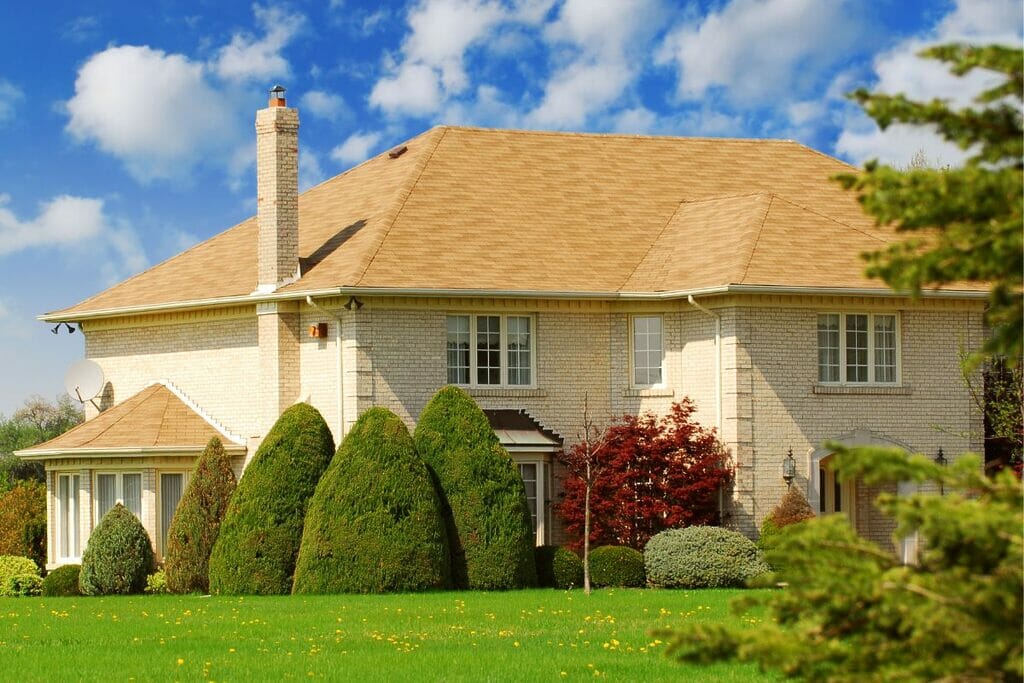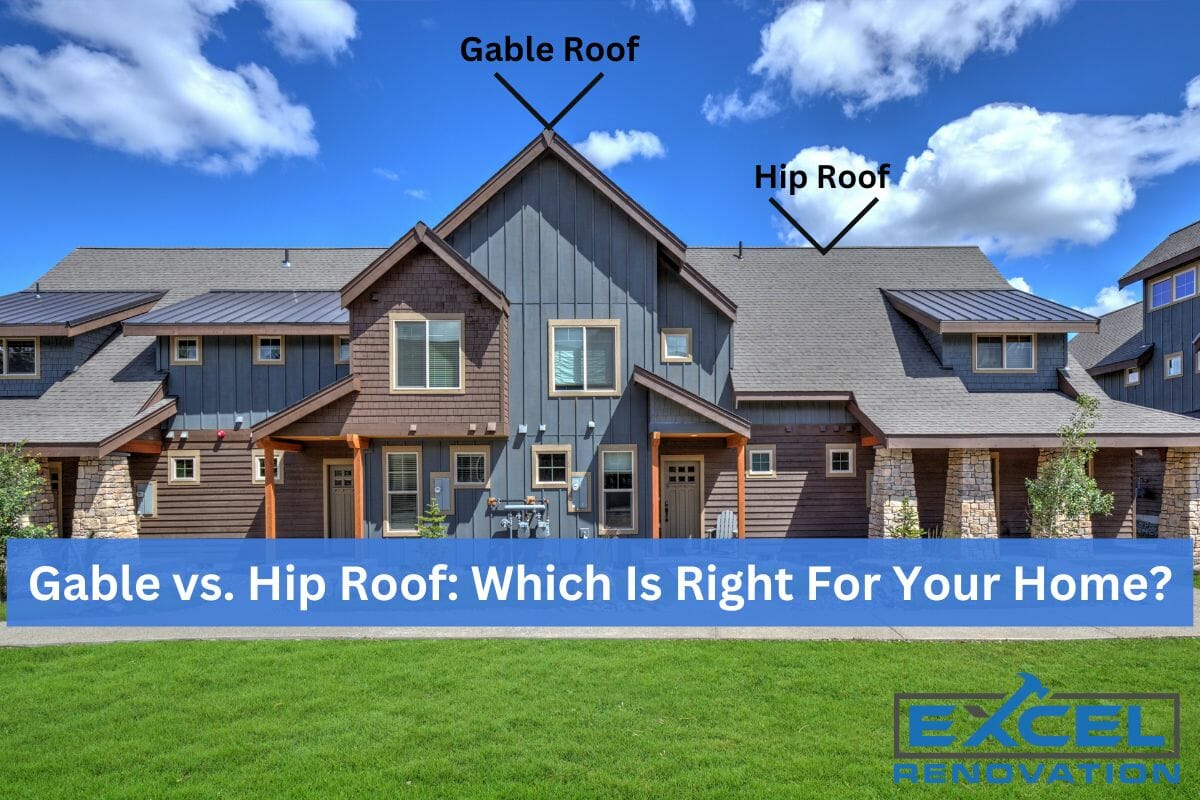Choosing the right roof design for your home can be challenging because there are many styles of roofs, each with a different set of pros and cons. From durability and cost to appearance and energy efficiency, the roofing style affects your home’s overall value and comfort.
At Excel Renovation, we have years of experience helping homeowners get the perfect roof for their homes. So, let’s look into the debate between a gable vs. hip roof, and compare these two popular roofing options!
A Gable Roof Overview

Gable roofs are popular among homeowners due to their classic and timeless appearance. A gable roof is characterized by its triangular shape, formed by two slopes that meet at the ridge or peak of the roof. The sides of a gable roof can be steep or shallow, depending on the local climate and the architectural style of the home.
Gable Roof Benefits
One advantage of gable roofs is that they are relatively simple to construct and are often less expensive than other types of roofs. Gable roofs also provide ample attic space and allow for good ventilation, which helps improve energy efficiency. Steep gable roofs can also shed water and snow pretty well, which can be an added benefit for people living in cold or rainy areas.
Potential Drawbacks Of Gable Roofs
Gable roofs do have some disadvantages as well. They can be prone to wind damage if not adequately braced. So, if you live in a windy or storm-prone region, your gable roof may require additional maintenance and bracing on the sides to remain sturdy and durable.
Also, if you’re looking for a unique and architectural roof design, a simple gable roof may not serve this purpose. But fortunately, you can choose a different gable roof design than the simple gable. For example, a cross gable or Dutch gable roof may cost more to install, but they are far more appealing than the standard triangular profile.
In conclusion, gable roofs are a solid choice for homeowners looking for a steep or low-slope roof design that is cost-effective and has more attic space.
Now let’s take a closer look at hip roofs, and how they compare to gable roofs.
A Hip Roof Overview

The hip roof design is the second most popular choice among homeowners in the United States. This is due to their attractive appearance and sturdy benefits. A hip roof features four sloping sides that meet at the ridge or peak of the roof. Unlike a gable roof, a hip roof has no vertical sides, and instead, all sides of the home’s roof are covered and slope downwards.
Hip Roof Advantages
Hip roofs are a stylish and practical choice for homeowners looking for a durable and low-maintenance roofing option. Characterized by their four sloping sides, hip roofs offer several benefits over other types of roofs.
- For starters, hip roofs are well-suited for areas with high winds due to their aerodynamic design. The four slopes of a hip roof allow wind to flow easily over and around the roof, reducing the risk of wind damage.
- Hip roofs are known for their durability, primarily due to their sturdy construction and absence of slope-less sides, which are areas of vulnerability commonly found on gable roofs. Hip roofs can also accommodate gutters all around the house, which can be highly beneficial for areas prone to thunderstorms or heavy rain.
- In terms of aesthetics, hip roof designs look more appealing and can complement a wide range of architectural styles, including French and Colonial styles.
Potential Disadvantages Of Hip Roofs
Hip roofs can be bigger and more complex to construct than gable roofs due to their design and the need for additional framing. This can increase the installation cost of a hip roof. Additionally, the sloping sides of a hip roof reduce the amount of attic space, which may be a concern for homeowners who need room for extra storage or want to have an additional living space.
Finally, most hip roof styles are suitable for homes, garages, or sheds, having a low to medium roof pitch, which is ideal for warmer states and mild climates. However, homes in the snowy parts of the country require a steeper roof to shed snow better. Low-pitched hip roofs have a poor capacity for clearing snow. This leads to heavy snow loads accumulating on the roof, which can deteriorate the shingles faster.
Overall, hip roofs are an excellent choice for homeowners who want a durable, low-maintenance, and unique roof design that can handle high winds or heavy rains.
Now, let’s compare gable and hip roofs in more detail to help you make an informed decision.
Gable vs. Hip Roofs: A Detailed Comparison
As a homeowner, it is vital to learn the details of how one roof can be more beneficial to you than another. For that, you need to consider several parameters. Ultimately, the right choice for your home will depend on your specific needs and preferences.
Here’s a more precise explanation on which roof type may be best for your home:
Hip Roofs Can Be More Durable
Durability is a significant consideration when we talk about gable vs. hip roofs, hip roofs usually last longer than gable roofs due to their sturdy design with complete coverage.
Gable Roof Installation Is Initially More Affordable
Gable roofs require fewer shingles and have simple truss construction. On the other hand, hip roof installation can cost 30 to 40% more than a gable roof.
A Hip Roof Can Be More Cost-effective
While hip roof installation can cost more than gable roofs, these roofs can still be more cost-effective in the long run. This is because hip roofs are known to perform better in extreme weather conditions. This naturally results in lower maintenance and repair costs over time.
Gable Roofs Allow For More Creativity
Gable roofs allow for more creativity in design because they have only two vertical sides. The pointed eaves (roof edges) and remaining sides can be used to create interesting architectural features. For example, gables can be adorned with gingerbread house trim or carved brackets. These roofs are also more accessible and spacious, which is great for adding decorations for Christmas and other holidays.
Additionally, the space created by the gables can be used to add large windows or dormers, which will increase natural light and ventilation, in the attic or upper floors of a home.
Hip Roofs May Help With Roof Insurance Claims
Some insurance companies may offer lower homeowner’s insurance premiums for homes with hip roofs due to their increased durability and resistance to wind damage.
A Hip Roof Can Be Extended To Cover An Entrance Or Porch
A hip roof can be extended to create coverage for an entrance or porch by extending one or more of its sloping sides beyond the exterior walls of a building. This extended section of the roof is supported by posts or columns and creates a covered area that adds greater curb appeal to a home.
To create a covered entrance or porch using a hip roof extension, the slope of the extended section of the roof should match the slope of the existing hip roof. This will ensure the extension blends seamlessly with the existing roof and creates a cohesive architectural appearance.
Along with these considerations, you should also understand that the functionality and durability of your roof depend on a few more factors other than its design, which we’ve listed below.
Other Factors For Choosing The Best Roof For Your Home
When you decide on the design for your home, you should also choose suitable roofing materials and the right contractor to do the job. These are as important as choosing the type of roof you want.
Choose The Right Materials
The materials used to construct your roof can also affect its durability and performance. Be sure to choose materials that are appropriate for your climate and come with a good manufacturer warranty.
Work With A Reputable Contractor
Hiring the right contractor to install your roof is crucial. Make sure your roofing contractor is reputable, knows the local building codes, and has experience installing roofs using high-quality materials.
Proper Maintenance
Regular roof cleaning and maintenance are vital to ensure the performance and durability of your roof. As a homeowner, you should have a proper roof maintenance plan which includes inspections, cleaning, and any necessary repairs. This is especially important if you live in a coastal or storm-prone area of the country.
We hope our article on gable vs. hip roofs was helpful to you and aided your decision on which style to choose for your home. If you have a house in Plymouth, MN, we can help you get the best roofing system for your home.
Free Consultation and Estimate For Minnesota Homeowners
At Excel Renovation, we understand the importance of having a durable and reliable roof over your head, and we’re here to help. Our experienced professionals have been providing homeowners with the best roofing services in Minnesota. We offer free consultations, roof inspections, and estimates to help you find the perfect roofing solution for your home.
Excel Renovation is not just a business. We are part of your community, care about your safety and comfort, and are committed to providing you with the highest quality service. Let us help you get the perfect roof and give you peace of mind. Reach out to us at (612) 439-5005 to discuss your roofing options with one of our experts over a free consultation.

